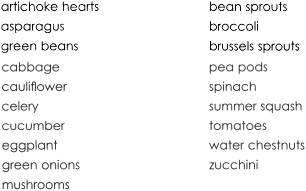
In this chapter I’ll share Martha McKittrick’s eating plan and recipes that my patients have followed with tremendous success. They will enable you to lose weight without having to abandon all of the foods you love. With this plan, success is not about deprivation, but substitution.
No matter what life throws at you, it will always be easier to handle if you’re in control of your weight. Failing again and again to meet your weight loss goals, or feeling out of control in your life, can be totally reversed by everyday smart thinking, such as saying no to a bread basket, piece of cake, or bag of pretzels. To change your weight, you need to change your thinking. Let’s get started.
Here are some pointers to eating right, arranged in four steps. You need to pay attention to directions and amounts, and also to your body’s reaction to what and how much you eat. If you have doctor’s orders to avoid something, those orders override suggestions here. But it’s not all about avoiding and saying no. Look for foods you like in the food lists provided in this chapter and enjoy them.
Portion sizes are important. Unlike many popular low-glycemic diet plans, we focus on portion control and do not allow eating unlimited amounts of protein and fat. Therefore, you will need to weigh certain foods on a food scale and measure other foods in a measuring cup until you feel you can eyeball portions accurately.
• Use a food scale to weight cooked protein and cheese as well as dry pasta and potatoes, if you choose to incorporate these foods into your eating plan.
• Use a measuring cup to measure cooked starches, such as rice, oatmeal, and other grains.
• Use measuring spoons for oils and salad dressings.
Try not to skip meals and snacks. Eating small meals regularly helps control overeating.
Avoid alcohol. Not only is alcohol an empty source of calories, but it can also reduce your willpower to watch what you eat. In addition, it is not recommended that you drink alcohol if you are taking metformin (Glucophage). Therefore, alcohol should be saved for special occasions—and the metformin should not taken at the same time. Ideally, you should also account for the calories in alcohol by omitting calories from your eating plan. An average drink (6 ounces wine, 1½ ounces hard liquor) has about 100 calories. Avoid alcoholic beverages with sweet mixers, such as rum and Coke.
Take a multivitamin supplement. It is almost impossible to eat a perfectly nutritionally balanced diet, especially if you are on a reduced calorie diet. While real food is always best, a multivitamin can help provide your body with some of the nutrients your diet may be lacking. For women taking metformin, it is especially important to take multivitamins, because metformin can deplete or interfere with the absorption of vitamin B-12 and folic acid. Lastly, if you are not consuming 1,200 mg of calcium a day from food, I recommend that you take a calcium supplement.
Pay attention to how your body feels after eating various foods. If you find a particular meal suggestion (for example, a breakfast of yogurt, bran cereal, and nuts) does not satiate you, omit that meal or snack from your eating plan and focus on the meals that do satisfy you (perhaps the egg white omelet with veggie sausage and light toast).
Customize. For more flexibility, we have included lists of approved starches grains, fruit, and nuts that you can substitute for foods listed in the meal plans. For example, if you do not like the fruit on the menu for Monday, feel free to choose another from the fruit list. The same goes for starches/grains and nuts. (Do not eat grapefruit if you are taking Lipitor or other statins.)
Don’t forget your food history. If you have always had difficulty controlling portions of a certain food, for example, nuts or bread, do not include that food in your meal plan.
Eat your favorite foods. Many of my patients ask if they can incorporate some of their favorite “non-diet” foods into their eating plans on occasion. The answer is absolutely! No one should feel deprived 100 percent of the time. Maybe plan to have a moderate portion of your mother-in-law’s famous lasagna at a family get-together, or split a piece of cheesecake with your husband at your favorite restaurant. The key is that these indulgences need to be moderate, planned, and done only on special occasions—I might suggest twice a month. However, if you are trying our accelerated weight-loss plans, try to adhere to them strictly for at least three weeks before adding treats. Lastly, if you find that straying from the diet plans “sets you off,” avoid indulgences—or at least stick to those treats that do not trigger uncontrolled eating.
Take your special needs into account. For those of you who are trying to limit your sodium intake, make sure to read food labels. Some of the soups and cheese products in the My Favorite Food section may contain fairly high amounts of sodium. Select lower sodium products when available.
Use a cooking spray, instead of oil or butter, whenever you can.
Pile on the greens. Salad greens can be consumed in unlimited amounts.
Most vegetables welcome. The following vegetables are low in calories (approximately 50 calories per cup cooked) and fairly low in carbs (approximately 6 to 8 grams per cup cooked):

While it is unlikely that anyone ever gained weight from eating too many green beans, on our accelerated weight loss program, we still recommend that you account for your calories from vegetables.
Drink plenty of fluids. Water, seltzer, diet drinks, regular and decaf tea, and regular and decaf coffee are all allowed. What you drink can have an effect on your health. It has been suggested that tea can help decrease the risk of cancer and heart disease. In addition, it may play a role in weight loss. For those of you who enjoy a cup of coffee, recent research has shown some health benefits as well. However, other studies have linked caffeinated beverages to increased insulin resistance. I, therefore, urge moderation in consumption of all caffeinated beverages, including coffee, tea, and diet sodas.
Hidden calories. Be careful with salad dressings. There is no easier way to ruin a healthful low-calorie meal than to top it with 300 calories of a dressing! Consume a maximum of 70 calories for salad dressing. Your choices include:
• 1½ teaspoons of oil and unlimited vinegar amounts to 70 calories.
• 2 tablespoons of light commercial dressing can range from 10 to 80 calories. Check the label, since calories vary widely.
• 1 tablespoon creamy commercial dressing can be 60 calories or more. Again, check the label. In a restaurant, if a light dressing is not available, order the regular dressing on the side and use only 1 tablespoon. Add extra vinegar if needed. You can do the same with your favorite higher calorie salad dressings at home.
• Your best bet is making your own dressing. You can keep the calories down by adding in more of the lower calorie ingredients (vinegar or buttermilk) and less oil of the higher calorie ingredients (oil or cheese).
Artificial sweeteners are allowed—but moderation is best! Many women prefer the taste of Splenda. Word of caution: Pay attention to how your body feels after consuming artificial sweeteners. If you find they trigger cravings, you may be best off avoiding them.
DRINK WATER TO SPEED WEIGHT LOSS
A study by German researchers concluded that people who drink two 8-ounce glasses of water before a meal increased their rate of calorie burning by up to 30 percent about forty minutes later, and that rate stayed elevated for more than an hour. They concluded that drinking eight 8-ounce glasses of water could help burn an extra 35,000 calories a year! There are other benefits to drinking water. When you start dieting, your body loses fluid. If you don’t get enough fluid, you’re more prone to constipation and fluid retention, which can hide your actual weight loss. Dehydration can make you feel weak, and this may cause you to exercise less and eat more to compensate for the lack of energy. Most importantly, all biochemical reactions in the body, including digestion, take place in the presence of water. Adequate fluid intake allows your body to conduct its normal calorie burning process.
You should eat three meals a day, at the same times each day, as often as possible, plus a snack between breakfast and lunch, lunch and dinner, and after dinner, for a total of three per day. See chapter 6 for information on your daily calorie intake, and chapter 8 for the amount of physical exercise you should do each day.
The calories, carbs, and fat grams listed for the meal plans are estimates. They will vary depending on the product you choose. For example, the bread you choose may be lower in carbs and/or calories than the bread used in these plans, or the cheese you choose may be lower in calories and fat.
For you carb/gram counters out there, take note: I did not subtract the fiber from the total carbohydrate content in these meal plans. Many of the products in the My Favorite Foods section, pages 129-32, as well as foods in the meal plans, are high in fiber. As previously discussed, those of you are who are counting grams of carbohydrate may subtract the grams of fiber (if there are 5 grams or more per serving) from the total amount of carbohydrates. For example, two GG Scandinavian Crisp bread crackers contain 6 grams of carbs and 6 grams of fiber. The calculations in this plan count the crackers as 6 grams of carbs, whereas if you are counting grams of carbohydrate, you may count this product as 0 grams of carbohydrate.
The following meal plans contain approximately 1,100 calories a day, with 35 percent of the calories coming from carbs. These meal plans emphasize lower glycemic index carbs from vegetables, fruit, and whole grains. For the accelerated weight loss program, it is generally recommended that obese women with PCOS consume an 1,100 calorie diet.
For breakfast, target a calorie range from 140 to 210, grams of carbohydrate from 8 to 30, and grams of fat from 1 to 15. Initially, to accelerate weight loss and build momentum, you may want to focus on choices that are the lowest in calories, carbs, and fat.
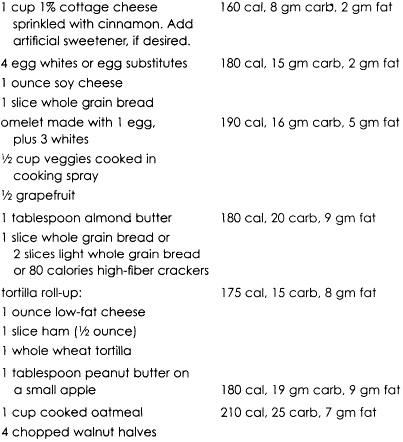
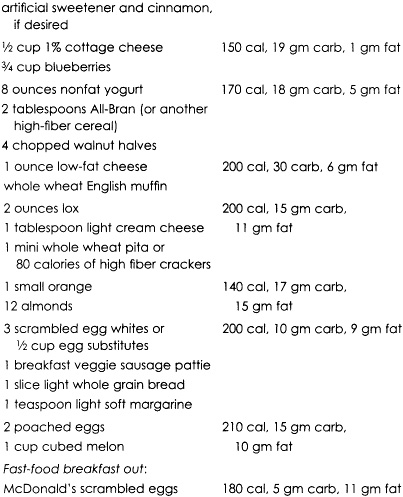
For lunch, calories should range from 280 to 420, grams of carbohydrate from 3 to 25, and grams of fat from 5 to 30.
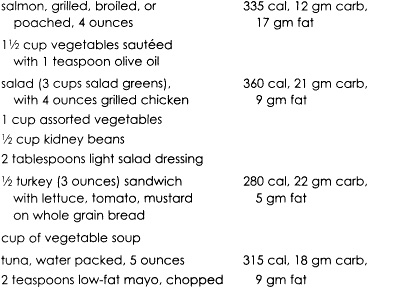
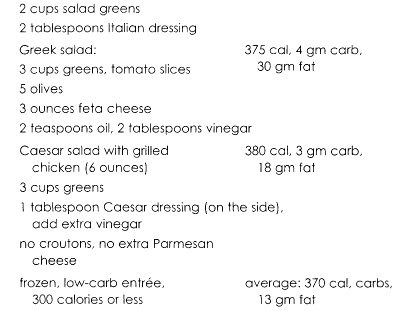

For snacks, calories should range from 60 to 150, grams of carbohydrate from 0 to 20, and grams of fat from 0 to 8.

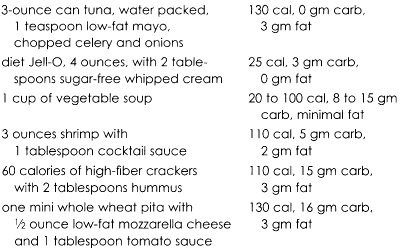
For dinner, calories should range from approximately 300 to 450, grams of carbs from 10 to 44, and grams of fat from 8 to 27.
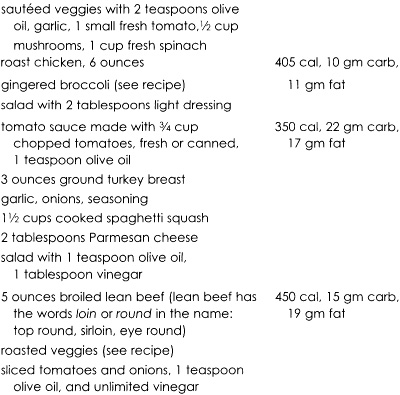
FOODS THAT HELP CONTROL BLOOD SUGAR
There’s a safe, natural food on the market that can help stabilize your blood sugar, yet it has no calories and tastes great. Sounds too good to be true? The latest research, conducted by Richard Anderson, Ph.D., at the Beltsville Human Research Nutrition Center in Maryland, shows that eating just half a teaspoon of cinnamon a day can do all that. If you find yourself overeating, the research suggests that your body may store fewer calories if you introduce cinnamon into your diet. It seems that cinnamon improves insulin activity in cells by increasing the rate at which they covert sugar to energy. Fat cells depend exclusively on sugar, so keeping your blood sugar levels stable deprives them of their one and only food source. Dr. Anderson’s finding show that cinnamon can cut blood sugar levels by 20 to 30 percent.
Cinnamon is not the only food that helps fat cells behave more efficiently. In a study in which researchers gave the same amount of food to two groups of dieters, the group that got low-fat, high-calcium dairy foods lost up to 70 percent more weight. The research also shows that low-fat, high-calcium dairy foods can increase the loss of overall body fat by 64 percent, and help reduce belly fat by nearly 50 percent. This is great news for women with PCOS, who tend to gain excess weight around the abdomen.
It’s obvious that when you eat out, you often have little control over what exactly goes into the dish you order. But if you can’t control the ingredients and preparation methods, at least you can select a restaurant that doesn’t reek of burning fat.
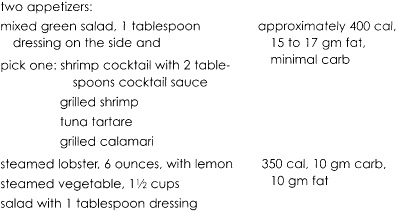
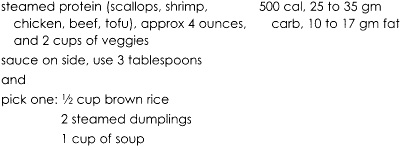
If you choose to eat raw fish (for example, tuna tartare and sashimi) on occasion, do so at a reputable fish restaurant.


Ask for minimal oil with preparation (assume 1 tablespoon).
Digestion takes energy, and your body uses food calories for energy. The amount of caloric energy it takes to digest and process the foods you eat is called is called thermogenesis. Different foods require different amounts of energy to digest, which means that the foods you choose can play a critical role in whether you gain or lose weight. Lean proteins such as fish, shrimp, and white-meat chicken have the highest thermogenic effect, with a full 30 percent of their calories being burned up during digestion. Conversely, simple carbohydrates such as cakes and bagels have a poor thermogenic effect, burning only 6 to 8 percent of their calories during digestion. High-fat foods have the poorest thermogenic effect, burning only 3 percent of their calories before going right to storage (often around your abdomen, if you have PCOS). White-meat chicken, fish, and seafood; high-fiber, low-starch green and white vegetables; egg whites; and high fiber are four thermogenic winners that speed up your metabolism, offer large volume, and put an end to out-of-control eating.
While many of the big restaurant chains these days appear to be making serious efforts to provide healthy choices on their menus, some of the choices promoted as low in fat are high in unmentioned calories. Here are some choices that fit within the eating plan’s guidelines at the time of this writing.






Foods that fill you up quickly, so you don’t overeat but still feel satisfied, are essential for dealing with the symptoms of PCOS. In a well-known study by Australian researchers, fish and seafood came in second overall (to boiled potatoes) as the most satisfying or filling food and was the top protein on the list. Other foods that fill your stomach without expanding your waistline include green and white low-starch vegetables, low-fat dairy foods, eggs whites, and lean or low-fat cuts of beef.
For any healthy food regimen to work, you have to enjoy what you are eating. If you don’t, it won’t be long before you find an acceptable excuse to eat something more to your liking. When you find healthful foods that you really enjoy, take note of them so that you can have them again. Here are some of my favorites:
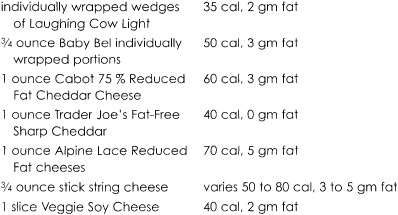

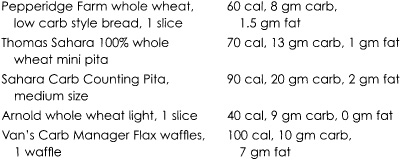
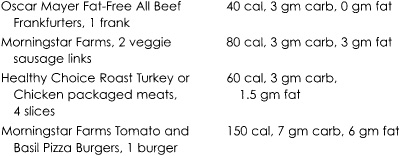

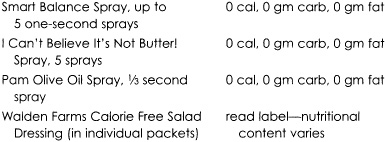

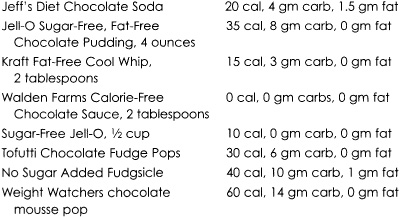

These condiments have minimal calories, carbs, or fats:
Flavored vinegars, such as tarragon, balsamic, herb
Hot sauce
Salsa
Wine or chicken broth for cooking
Fresh ginger, garlic, and other herbs
Nuts contain 160 to 200 calories per ounce, 13 to 20 grams of fat, and minimal carbs. Composed of both protein and fat, nuts are a great snack if you can control your portion size. They are filling and healthy. Different types of nuts (almonds, walnuts, pecans, pistachios, or peanuts) can improve your blood lipid levels and have a beneficial effect on cardiovascular risk. In addition, the Nurses’ Health Study and Seventh Day Adventist Study have found lower body weights associated with increased nut consumption. While you can’t lose weight on a nut-only diet, they may help you control your body weight. That said, if you can’t limit yourself to a handful at a time, it’s best to avoid them!

Try opticarbs for a group of low-glycemic carbohydrates that speed up weight loss while eliminating the cravings and hunger that sabotage so many diets. Opticarbs promote weight loss by controlling hunger and cravings, especially for high-glycemic carbohydrates, which can cause dramatic spikes in blood sugar; and by providing generous portions and superior nutrition for relatively few calories.
Opticarb foods include:
• High-calcium dairy, especially low- and non-fat yogurts, low-fat and fat-free cheeses, milk, and select dairy-based shakes.
• Green and white low-starch vegetables such as asparagus, broccoli, cucumber, cauliflower, and mushrooms. These vegetables are filling and full of fiber. High-fiber foods are important if you have PCOS, because they help slow the conversion of carbs into blood sugar, ensure healthy digestion and proper waste elimination, and control fat absorption. Fiber also binds to excess cholesterol and helps eliminate it from the body.
• GG Scandinavian Crisp bread is the only grain on the market that has zero “absorbed” carbs (the amount of carbs that have a tangible effect on your blood sugar), while supplying more fiber and fewer calories than other grains. If you have a history of abusing bread, they’re the perfect substitute!
Opticarbs promote success at weight loss. Truly, they give you the carbs … without the consequences.
Prepackaged meals and fixed amounts of food can tell you exactly how many calories you’re getting, so that you’re less likely to overeat. In one study, dieters who had portion-controlled meals—such as TV dinners—lost 30 percent more weight than those who did not.
Here are some recipes to get you started on preparing the kind of healthful meals that will make a difference in your life. There are many suitable cookbooks to select recipes from and have adventures in preparing PCOS-friendly meals.
TURKEY MARSALA
2 turkey cutlets (7 ounces each)
2 tablespoons flour
cooking spray
2 teaspoons oil
½ pound mushrooms (button, shiitake, etc.), cleaned and sliced
 cup Marsala wine
cup Marsala wine
fresh ground pepper and salt to taste
Coat the cutlets with flour. Spray nonstick pan with vegetable cooking spray and sauté the cutlets about 2 minutes on each side. Remove. Add the 2 teaspoons oil to the same skillet and sauté the mushrooms until softened, about 4 minutes. Remove the mushrooms. Add the Marsala to the pan and cook for a few minutes over high heat. Add the turkey cutlets and mushrooms and heat for a minute or two. Add salt and pepper to taste.
2 servings 280 CAL, 8 GM CARB, 7 GM FAT PER SERVING
2 chicken cutlets (6 ounces each), thinly sliced or pounded thin cooking spray
2 teaspoons vegetable oil
1 small red onion, chopped
½ cup chicken broth
2 to 3 tablespoons balsamic vinegar
¼ teaspoon dried thyme
salt
freshly ground pepper
Cook the chicken cutlets in nonstick pan with cooking spray about 5 minutes on each side. Remove from the pan. Add 2 teaspoons of oil to the pan and sauté the onion for 5 minutes until soft. Add the chicken broth and balsamic vinegar and thyme; cook until the liquid reduces by a third. Add the chicken until it is heated. Season with salt and fresh pepper to taste.
2 servings 245 CAL, 3 GM CARB, 5 GM FAT PER SERVING
STIR-FRY RECIPE
5 ounces protein (chicken, shrimp, tofu, scallops, lean beef, or pork tenderloin)
4 cups assorted raw veggies (this will decrease to approximately 2½ cups when cooked):
scallions, trimmed and thinly sliced
thinly sliced cabbage
shiitake or other mushrooms, sliced
carrots, cut into thin slices
broccoli flowerets
1 teaspoon sesame or vegetable oil
1 garlic clove, crushed
1 tablespoon light soy sauce
½ cup chicken broth (regular or low sodium)
2 tablespoons rice wine or dry sherry
optional: fresh grated ginger, 1 to 2 teaspoons
hot mustard powder, ¼ teaspoon
crushed red pepper flakes, pinch
Stir frying is quick, so make sure you prepare the ingredients first. Slice the protein into thin strips. Cut the vegetables into julienne strips or bite-size pieces. Heat 1 teaspoon of oil in a nonstick pan. Add the protein and crushed garlic and cook for 3 minutes. Add the veggies; cook for 5 minutes or so, stirring frequently. Then add in the soy sauce, chicken broth, rice wine or dry sherry, and optional ingredients. Let this simmer for a few minutes until the vegetables are tender but not too soft. You may find that you want to adjust the ingredients the next time you make this recipe. Some people prefer it spicy, with more or less soy sauce, etc. Be creative—make it the way you like it!
1 serving |
|
| APPROXIMATELY 325 CAL, 12 GM CARB, 8 GM FAT, INCLUDING THE PROTEIN. OR, IF MADE JUST WITH VEGETABLES, APPROXIMATELY 110 CAL, 10 GM CARB, 4 GM FAT FOR 1½ CUPS. I RECOMMEND DOUBLING THIS RECIPE SO THAT YOU HAVE LEFTOVERS FOR ANOTHER MEAL. |
ROASTED VEGGIES
1 red bell pepper and 1 yellow pepper, cored, seeded and cut into strips
1 cup fennel, sliced
2 red onions, peeled and cut into wedges
2 medium zucchini
8 ounces mushrooms, sliced
4 garlic cloves, peeled and thinly sliced
1 tablespoon balsamic vinegar
1 tablespoon olive oil
Pinch of dried or fresh herbs, if desired: oregano, thyme, rosemary, tarragon, parsley
Preheat oven to 425 degrees. In a large bowl, toss together all of the above ingredients. Place the vegetables in a baking dish or roasting pan; roast for 20 minutes or until tender and slightly browned, stirring several times. Add salt and freshly ground pepper as needed.
Approximately 3 servings 95 CAL, 8 GM CARB, 5 GM FAT PER 1 CUP SERVING
1 tablespoon grated fresh ginger root
2 crushed garlic cloves
¼ cup rice vinegar
1 to 2 teaspoons Splenda
2 tablespoons light soy sauce
1 head broccoli
Combine the ginger, garlic, vinegar, Splenda, and soy sauce in a saucepan and bring to a boil. Wash the broccoli and cut into bite-size florets. Place in pan and cover. Steam for 5 minutes or until tender. Serve with some of the sauce.
60 CAL, 5 GM CARB PER 1 CUP SERVING
MASHED CAULIFLOWER
1 head cauliflower, washed and cut into bite-size pieces
butter spray or 2 teaspoons light margarine (light margarines tend to have low levels of trans fats)
1 to 2 tablespoons skim milk
salt and pepper to taste
Steam or microwave the cauliflower until tender, When cool, pat dry with paper towels to remove excess water. Add the butter spray or margarine and mash with a hand masher or blend in a food processor until smooth. Add 1 to 2 tablespoons of skim milk to thin, if needed. Add salt, pepper, and paprika to taste.
50 CAL, 6 GM CARB PER 1 CUP SERVING
¼ cup all-purpose flour
1 teaspoon Creole seasoning
½ teaspoon cayenne pepper
½ teaspoon black pepper
½ teaspoon garlic powder
1 teaspoon onion powder
1 tablespoon paprika
4 boneless pork chops (3 ounces of meat on each chop)
2 teaspoons canola oil
Whisk the flour and seasonings together in a pie pan or shallow bowl. Coat each pork chop. Heat the oil in a nonstick pan. Cook the pork chops approximately 7 minutes on each side over medium heat or until cooked through.
4 servings 205 CAL, 6 GM CARB, 9 GM FAT PER SERVING
BLACK BEAN SALAD
One 15-ounce can black beans, rinsed and drained
½ can (15-ounce) whole kernel corn, drained
4 green onions, chopped
1 jalapeño pepper, seeded and minced
½ red bell pepper, chopped and ½ green bell pepper, chopped
½ avocado, peeled, pitted, and diced
½ jar (4 ounces) pimentos
1½ tomatoes, seeded and chopped
½ cup chopped fresh cilantro
½ lime, juiced
¼ cup low-fat Italian salad dressing
¼ teaspoon garlic powder
Combine all the ingredients in a large bowl. Toss. Chill and serve.
6 servings 158 CAL, 32 GM CARB, 18 GM FAT